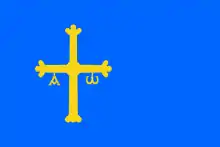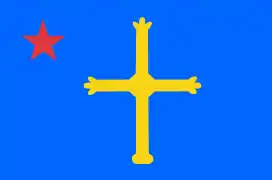Flag of Asturias
The flag of Asturias shows the "Cruz de la Victoria" (Victory Cross) in yellow (PMS 109) over blue (PMS 829).
 | |
| Name | Asturina, Azuleste[1] |
|---|---|
| Use | National flag and ensign |
| Proportion | 2:3 |
| Adopted | December 19, 1990 (current version, as established in Law 4/1990) |
| Design | The Victory Cross in yellow, off-centred toward the hoist, over blue. |
.svg.png.webp) Variant flag of Asturias | |
| Use | Civil flag and ensign |
| Proportion | 2:3 |
| Adopted | 28 May 1785 (original naval ensign version) 5 October 1981 (current version, changed coat of arms) |
| Design | The Victory Cross in yellow, centred, over blue. |

History
The origin of the flag of Asturias is in 1808, during the Peninsular War. As there was not any Spanish national flag yet, Asturians created the current flag, without any separatist intention in the war against the Napoleon's empire.[2] In its first version, it included the motto Asturias jamás vencida (Asturias never defeated).
Design
According to the tradition, the Victory Cross was carried by Pelagius, first King of Asturias, in the decisive Battle of Covadonga against the Moors in 722. This battle, fought in the mountains of Asturias, was hailed by 19th and 20th century historiography as the start of the Reconquista, the Christian re-conquest of the Iberian peninsula from the Moorish domination. However, there is not any historical evidence about the use of this cross.
In 908 the Asturian King Alfonso III the Great ordered that the original wooden cross, made of oak, be clad in gold and precious stones. Currently, it is kept in the Holy Chamber of the Oviedo Cathedral.
The Greek letters Alpha and Omega hang from its horizontal axis. This is a direct reference to the Book of Revelation (verses 1:8, 21:6, and 22:13)., I am the Alpha and the Omega, the beginning and the end, says the Lord God, who is, and who was, and who is to come, the Almighty.
Variations
.svg.png.webp) Formal variant
Formal variant Nationalist flag, with the red star
Nationalist flag, with the red star
See also
References
- Miguel Ramos Corrada (2002). Historia de la Lliteratura Asturiana (in Asturian). ISBN 9788481683356. Retrieved 8 September 2016.
- "Los tres momentos históricos en los que Asturias pudo ser independiente" (in Spanish). La Voz de Asturias. 8 September 2016. Retrieved 8 September 2016.
| Wikimedia Commons has media related to Flags of Asturias. |